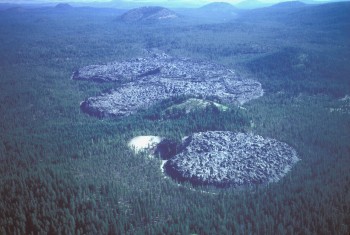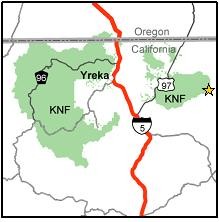Pumice Crater and Crater Glass Flow Geologic Area

Pumice Crater with its associated obsidian flow in the foreground and Crater Glass flow beyond. Photo By Julie Donnally-Nolan.
Pumice Crater and Crater Glass Flow Geologic Area is an 800-acre site that includes stunning geologic features. Red and white cinder cones overlook vast deposits of volcanic glass and pumice, as well as ancient faults and fissures. The features you see here record some of the complex geologic events which formed Medicine Lake Volcano (part of the Cascade Range) and have shaped the surrounding landscape.
Geologic Background
As oceanic crust dives beneath the western margin of the US, the crust is heated, forming the magma chambers which have built the mountains of the Cascade Range and the composite shield volcano known as Medicine Lake Volcano. The Pumice Crater and Crater Glass Flow Geologic Special Interest Area is situated on the northwestern flank of this large volcano showing evidence of geologically recent extension of the earth's crust and resulting volcanic activity. These glass flows erupted at about the same time as Little Glass Mountain, which is located to the southwest along the same eruptive fissure.
Geologic Processes at Work
The majority of rocks flanking the broad slopes of the ancient Medicine Lake Volcano are basalt and andesite. These two rocks contain a relatively low percentage of silica (SiO2) compared to lighter colored rocks such as rhyolite. Silica makes lava thicker and increases viscosity. The low viscosity, fluid lavas erupted by Medicine Lake Volcano gave the mountain its shield–like, low profile. Silica–rich lavas make for explosive eruptions, because the high viscosity lavas can cause more pressure to build within the eruptive vents. These intense eruptions resulted in widespread pumice deposits and high–relief obsidian glass flows.
On your hike to Crater Glass Flow, you will see 10' wide cracks in the basaltic andesite that you are walking on—some are over 20' deep! The cracks formed roughly 1,000 years ago as silica–rich lavas erupted from nearby vents.
At the larger glass flow, note that the adjacent cinder cone was cut by a fault. The fault scarp is indicated by bright red cinders. Follow this fault southwest to a larger, pumice–mantled crater and another glass flow for which Crater Glass Flow Geologic Area was named.

Northeast view of Crater Glass Flow
Cultural Significance
Obsidian within the Medicine Lake Highlands has been used for thousands of years by numerous American Indian tribes. With a cutting edge sharper than a surgical scalpel, obsidian was formed into a variety of everyday tools. Often these tools, and the flakes from their manufacture and maintenance, are the only traces left of past human activities on the landscape. Obsidian from the Medicine Lake Highlands was a principal trade item and has been found as far away as California 's northwestern coast and central valley. Obsidian and obsidian source locations have spiritual as well as functional value for American Indians; as such these areas continue to be of special interest to today's American Indians.
Collection of obsidian from Pumice Crater and Crater Glass Flow Geologic Area is prohibited. Natural features and archeological and historical objects are protected by federal law. You can help preserve America's past by leaving archaeological and historic remains undisturbed, encouraging others to do the same, and reporting information about disturbances of these remains to National Forest personnel.

Generalized map of Pumice Crater and Crater Glass Flow.
References
Donnelly–Nolan, J.M., in press. Geologic Map of Medicine Lake Volcano, northern California: USGS Scientific Investigations Map 2927, scale 1:50,000.


